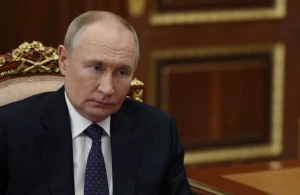
Why South Korea refuses to supply weapons to Ukraine, Ukraine’s demining efforts. Serhiy Zgurets' column
South Korea has declined to supply Ukraine with arms. Ukraine had hoped Rustem Umerov's visit to Seoul would secure Shingung air defense systems, capable of targeting aircraft over 100 kilometers away, along with ammunition, artillery, and tanks
Russia deals another blow to Ukraine's energy system
On Thursday, November 28, Russia launched another massive attack on Ukraine's territory. As early as the evening of November 27, Russian forces launched drones, after which they attacked Ukraine with Kalibr missiles from the Black Sea, and later in the morning launched Kh-101 missiles from Tu-95 strategic bombers. In total, according to a report from Ukraine's Air Force Command, Russia used 188 long-range strike weapons, half of which were missiles and the rest were attack UAVs. This attack was once again directed at Ukraine's energy facilities. It is worth noting that the air defense forces managed to shoot down more than 90% of the Russian missiles. In particular, 76 Kalibr and Kh-101 missiles, as well as parts of an Kh-55 missile were found among the wreckage. This type of missile is used in the Kh-555 variant as a nuclear warhead. In total, about a dozen hits to Ukraine's energy system facilities were recorded. This attack has greatly damaged the Ukrainian energy system. That is why power engineers are now forced to increase electricity supply restrictions and are working to bring the equipment damaged by the Russian attack back into operation as soon as possible.
Against this backdrop, Ukrainian air defense forces reported not only the number of Russian missiles shot down but also the challenges involved in repelling the attack. It was noted that Russia is now deploying a significant number of missiles, and in some areas, Ukraine's capacity to intercept them is limited. Additionally, it was highlighted that Russia is enhancing its air attack capabilities. Specifically, the Russians are utilizing missiles equipped with heat traps and electronic warfare systems, making it more difficult to shoot them down. Furthermore, Russia is carefully preparing for these attacks, selecting optimal weather conditions to carry them out.
In general, it is understood that Russia has been stockpiling Kh-101 missiles for an extended period. Before this latest attack, the Russians had managed to accumulate more than 200 of these missiles. We can predict that they will continue targeting Ukraine's energy infrastructure. This underscores the ongoing urgency of strengthening air defense, particularly by increasing the number of air defense systems, a process that is currently underway. Yesterday, it has become known that the Netherlands has handed over three more launchers for the Patriot air defense system to Ukraine. It is also important to increase interaction between various units that ensure the downing of Russian attack vehicles.
In the context of strengthening Ukraine's air defense, it's worth mentioning Defense Minister Rustem Umerov's visit to South Korea. Kyiv had specific expectations for this visit, primarily seeking to acquire Shingung air defense systems from South Korea. These systems are capable of intercepting air targets at a range of over 100 kilometers. Additionally, Ukraine submitted a request for ammunition, artillery systems, tanks, and other equipment. Of course, Ukraine was prepared to purchase the full list of these weapons, rather than receive them as aid. However, the main South Korean channel SBS reported that Seoul is not ready for such steps. As for the Shingung air defense systems, it was reported that they are only being manufactured and will be available only after 2030.
As for ammunition, Kyiv understood the complexities of South Korean legislation, which does not allow direct supplies of weapons to countries at war, and therefore requested at least powder charges for shells. However, all of Ukraine's proposals were rejected, as well as the supply of radars for air defense systems and counter-battery weapons. It is clear that the situation may change as Seoul waits to see what position the new Donald Trump administration will take. Seoul will not rush to make such a decision, but Ukraine needs to continue working with this country.
Difficulties in the humanitarian demining of Ukraine's de-occupied territories
Oleksiy Padun, a lecturer at the SHERIFF Demining training center, said that Russia continues to seek to escalate threats to Ukraine. Russia is changing its approaches to influence not only the military and law enforcement agencies, but also the destabilization of society as a whole. Padun said that SHERIFF is more focused on humanitarian demining of the territory after the hostilities.
Oleksiy Padun emphasized that humanitarian demining is significantly different from demining conducted by the Ministry of Defense and the State Emergency Service. Humanitarian demining has several areas. In particular, informing the population about mine danger, technical and non-technical surveys. He noted that the most difficult is the demining of residential buildings and agricultural land. The company receives most orders for humanitarian demining from local authorities and private clients, and the company also cooperates with many international organizations to clear de-occupied territories.
According to Padun, humanitarian demining has state funding and grants from international partners. While funds are allocated for demining through Ukraine's Ministry of Economy as part of the United24 program, there are special programs that allocate funds directly to humanitarian demining.
Oleksiy Padun noted that local communities have the opportunity to conduct humanitarian demining on their own, but there is a whole list of requirements and procedures. First, you need to get certified by the Mine Action Operator in certain areas. Then you need to obtain the necessary permits for such activities. The relevant permits are granted by government agencies. He also noted that it is very important to train and educate demining specialists, as well as provide them with the necessary equipment to carry out humanitarian demining. That is, protective equipment and explosive detection devices.
Modern technologies enable faster and more efficient demining process
Oleksiy Padun also noted that it is very important to use the latest technological solutions in demining. This not only simplifies but also speeds up the demining process. For example, SHERIFF uses drones with magnetometers for humanitarian demining. Such drones can survey large areas very quickly and safely. The company also uses modern metal detectors that can detect explosive objects deep in the ground. SHERIFF is also actively cooperating with Kyivstar mobile operator, where they have developed an ultra-precise positioning geolocation for demining, which makes it easier to find explosive devices.
- News













































